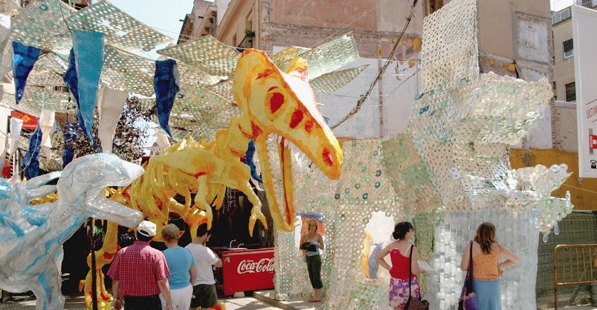14.08.2014 - 21:37
Gràcia’s Festa Major or Big Festival is about to start. From 15 to 21 August, neighbourhood streets and squares are decorated and there are dozens of activities, of all kinds and for all ages. A wide range of popular-culture events play an important role in the festivities. ‘Gegants’ [giants], ‘capgrossos’ [giant heads], ‘trabucaires’ [blunderbusses], ‘bastoners’ [baton dancers], ‘castellers’ [human pyramids] and ‘diables’ [devils] feature in many of the activities. Amongst other things the festival is famous for its decorated streets and squares; this year there are eighteen of them.
The Festa Major begins on the 15th, the day of The Dormition of the Mother of God. There will be firecrackers at 8 am, early morning graller music and popular breakfasts to wake up the local residents and announce the beginning of the festival. At 11 am, a ‘seguici’ [retinue] of popular culture groups will accompany the local authorities to a mass, in honour of the Mother of God. Once that is finished, it will be time for the Festa Major Morning where every neighbourhood popular culture group will do various dances in an order established by protocol. In the afternoon, a passacaglia featuring all Gràcia’s festive imagery and other guest groups will pass along the neighbourhood’s streets and squares. August 16th is the festival of Sant Roc, and the programme has scheduled activities in honour of the saint. In the morning there will be a passacaglia from Plaça de la Vila to the Chapel of Sant Roc — at the junction of Carrer Fraternitat and Carrer Llibertat—, where there will be a ‘trabucaire’ performance, a ‘ball dels gegants’ [giants’ dance] and the Castellers de la Vila de Gràcia will form a human pyramid. At midday, the district council offices will host a ceremony in recognition of the work done by the neighbourhood’s residents associations in decorating the streets and squares.
The ‘castellers’ will be the stars of the show on the 17th, with the ‘Casteller’ Morning, when there will be a meeting of various casteller groups, who will form human pyramids on Carrer dels Xiquets de Valls, and the Casteller Day, featuring the Xiquets de Reus, the Xicots de Vilafranca, the Minyons de Terrassa and the Castellers de la Vila de Gràcia. The Gràcia group will be back again on the 20th to do the famous walking pillar, from Plaça del Sol to Plaça de la Vila, and the Compline ‘casteller’ performance.
For the last ten years, the festival’s programme has included the Gràcia Culture Group Day, due to the strong presence of a wide variety of Catalan popular-culture groups in the neighbourhood. On the evening of the 18th, they will all meet at the La Violeta cultural centre and then form a passacaglia to Plaça de la Vila.
On the morning of the 21st, there will be a giants’ walk through the neighbourhood’s decorated streets. And in the evening, drummers, devils and beasts will take to the streets in a grand ‘correfoc’ [street fireworks] which will close the Festa Major.
The Feast of Sant Roc, on the 16th August
The Gòtic neighbourhood is the oldest part of Barcelona, a place where lots of buildings and streets have a special historical significance. It comes as no surprise, then, that the oldest festival still preserved in the city is held there, namely the Festes de Sant Roc, which are mainly held in Plaça Nova. These have been held without a break since 1589.
The Associació de Festes de la Plaça Nova is in charge of organising all the activities and ensuring they maintain the traditions of the celebration, which is why you can find all kinds of unusual features there. Leaving aside the ‘sardanes’, festival dances and the ‘cercavila’, you can also taste the traditional Sant Roc ‘panellets’, drink wine from a ‘porró llarg’, take part in the ‘cucanya’ competition and the dog festival, or join in the ‘seguici tradicional’.



